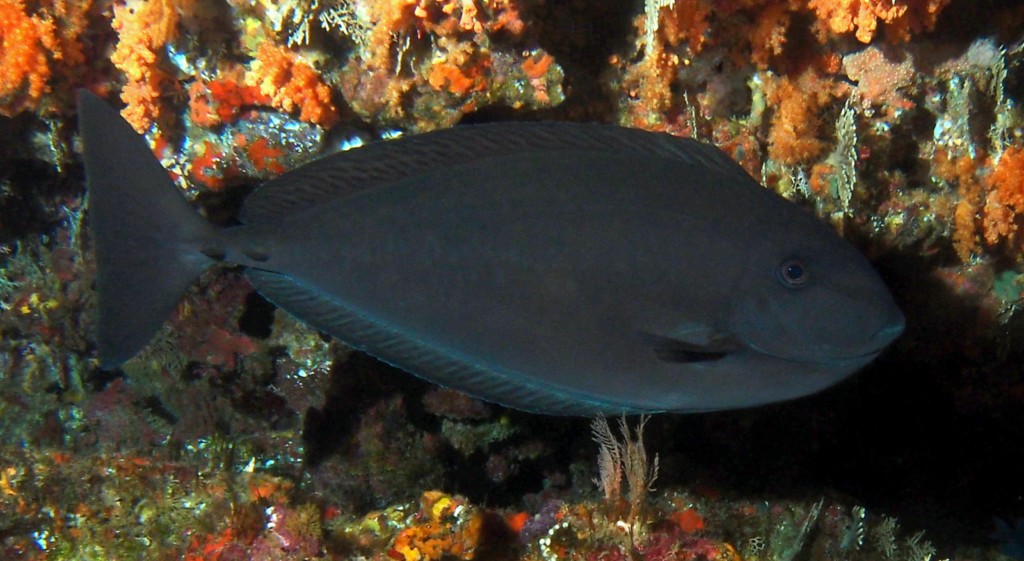NASO CAESIUS - (RANDALL & BELL, 1992)
Actinopterygii (Gigaclass) > Actinopteri (Class) > Teleostei (Subclass) > Acanthuriformes (Order) > Acanthuridae (Family) > Naso (Genus)
Nason gris, Gray unicornfish, Silverblotched unicornfish, Silver-blotched unicorn, Yumihari-tenguhagimodoki, ユミハリテングハギモドキ, 藍灰鼻魚, تکشاخماهی خاکستری,
Description
Dorsal spines (total): 6-7 (usually: 6); Dorsal soft rays (total): 27-30; Anal spines: 2; Anal soft rays: 28-31; Pectoral fin rays: 16-18; Body depth of subadults about: 2.2 in SL, of adults: 2.6-2.8 in SL; Two peduncular plates with knife-like keelsin adults; Caudal fin slightly emarginate to truncate. Max. length: 45.6 cm SL. Depth range: 15 - 50 m.
Color
Bluish grey to brownish grey dorsally, paler ventrally; No dark margin on operculum and preopercle; Capable of rapidly assuming a pattern of indistinct roundish to vertically elliptical blotches on upper half to tow-thirds of body which may be either darker or paler than ground color; Tong not black.
Etymology
Naso: from Latin, nasus = nose. Referring to “protuberance in the shape of a horn or a large magnifying glass on the nose” (translation, actually forehead) on adults of Naso fronticornis (= unicornis).
caesius: from Latin, caesius = bluish-gray. Named in reference to its most common ground color.
Original description: Naso caesius Randall & Bell, 1992 - Type locality: northern side of East Channel, Eniwetak or Enewetak Atoll, Marshall Islands, western Pacific, depth: 3-5 meters.
Distribution
Western Pacific, antiequatorial: Micronesia and Marshall Islands, north to Okinawa (Japan), east to Hawaiian Islands; Queensland (Australia) and New Caledonia, east to Tonga, Society Islands and Pitcairn Group.
Biology
Inhabits clear oceanic waters along steep dropoffs, offshore reefs and pinnacles. Benthopelagic. Occurs singly or in aggregations. Feeds in midwater on zooplankton.
Similar species
Naso caeruleacauda (Randall, 1994) - Reported from Western Pacific: Indonesia, east to New Ireland (Papua New Guinea), north to Philippines, south to northern Australia.
Naso hexacanthus (Bleeker, 1855) - Reported from New Caledonia - Link to the species (here).
Nason gris, Gray unicornfish, Silverblotched unicornfish, Silver-blotched unicorn, Yumihari-tenguhagimodoki, ユミハリテングハギモドキ, 藍灰鼻魚, تکشاخماهی خاکستری,
Description
Dorsal spines (total): 6-7 (usually: 6); Dorsal soft rays (total): 27-30; Anal spines: 2; Anal soft rays: 28-31; Pectoral fin rays: 16-18; Body depth of subadults about: 2.2 in SL, of adults: 2.6-2.8 in SL; Two peduncular plates with knife-like keelsin adults; Caudal fin slightly emarginate to truncate. Max. length: 45.6 cm SL. Depth range: 15 - 50 m.
Color
Bluish grey to brownish grey dorsally, paler ventrally; No dark margin on operculum and preopercle; Capable of rapidly assuming a pattern of indistinct roundish to vertically elliptical blotches on upper half to tow-thirds of body which may be either darker or paler than ground color; Tong not black.
Etymology
Naso: from Latin, nasus = nose. Referring to “protuberance in the shape of a horn or a large magnifying glass on the nose” (translation, actually forehead) on adults of Naso fronticornis (= unicornis).
caesius: from Latin, caesius = bluish-gray. Named in reference to its most common ground color.
Original description: Naso caesius Randall & Bell, 1992 - Type locality: northern side of East Channel, Eniwetak or Enewetak Atoll, Marshall Islands, western Pacific, depth: 3-5 meters.
Distribution
Western Pacific, antiequatorial: Micronesia and Marshall Islands, north to Okinawa (Japan), east to Hawaiian Islands; Queensland (Australia) and New Caledonia, east to Tonga, Society Islands and Pitcairn Group.
Biology
Inhabits clear oceanic waters along steep dropoffs, offshore reefs and pinnacles. Benthopelagic. Occurs singly or in aggregations. Feeds in midwater on zooplankton.
Similar species
Naso caeruleacauda (Randall, 1994) - Reported from Western Pacific: Indonesia, east to New Ireland (Papua New Guinea), north to Philippines, south to northern Australia.
Naso hexacanthus (Bleeker, 1855) - Reported from New Caledonia - Link to the species (here).
Last update: 11, October 2024
